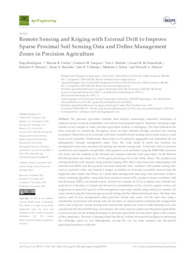Remote sensing and kriging with external drift to improve sparse proximal soil sensing data and define management zones in precision agriculture.
Remote sensing and kriging with external drift to improve sparse proximal soil sensing data and define management zones in precision agriculture.
Author(s): RODRIGUES, H. M.; CEDDIA, M. B.; VASQUES, G. M.; MULDER, V. L.; HEUVELINK, G. B. M.; OLIVEIRA, R. P. de; BRANDAO, Z. N.; MORAIS, J. P. S.; NEVES, M. L.; TAVARES, S. R. de L.
Summary: The precision agriculture scientific field employs increasingly innovative techniques to optimize inputs, maximize profitability, and reduce environmental impacts. Therefore, obtaining a high number of soil samples to make precision agriculture feasible is challenging. This data bottleneck has been overcome by identifying sub-regions based on data obtained through proximal soil sensing equipment. These data can be combined with freely available remote sensing data to create more accurate maps of soil properties. Furthermore, these maps can be optimally aggregated and interpreted for soil heterogeneity through management zones. Thus, this work aimed to create and combine soil management zones from proximal soil sensing and remote sensing data. To this end, data on electrical conductivity and magnetic susceptibility, both apparent, were measured using the EM38-MK2 proximal soil sensor and the contents of the thorium and uranium elements, both equivalent, via the Medusa MS1200 proximal soil sensor for a 72-ha grain-producing area in São Paulo, Brazil. The proximal soil sensing attributes were mapped using ordinary kriging (OK). Maps were also made using kriging with external drift (KED), and the proximal soil sensor attributes data, combined with remote sensing data, such as Landsat-8, Aster, and Sentinel-2 images, in addition to 10 terrain covariables derived from the digital elevation model Alos Palsar. As a result, three management zone maps were produced via the k-means clustering algorithm: using data from proximal sensors (OK), proximal sensors combined with remote sensors (KED), and remote sensors. Seventy-two samples (0–10 cm in depth) were collected and analyzed in a laboratory (1 sample per hectare) for concentrations of clay, calcium, organic carbon, and magnesium to assess the capacity of the management zone maps created using analysis of variance. All zones created using the three data groups could distinguish the different treatment areas. The three data sources used to map management zones produced similar map zones, but the zone map using a combination of proximal and remote data did not show an improvement in defining the management zones, and using only remote sensing data lowered the significance levels of differentiating each zone compared to the OK and KED maps. In summary, this study not only underscores the global applicability of proximal and remote sensing techniques in precision agriculture but also sheds light on the nuances of their integration. The study’s findings affirm the efficacy of these advanced technologies in addressing the challenges posed by soil heterogeneity, paving the way for more nuanced and site-specific agricultural practices worldwide.
Publication year: 2023
Types of publication: Journal article
Unit: Embrapa Soils
Observation
Some of Embrapa's publications are published as ePub files. To read them, use or download one of the following free software options to your computer or mobile device. Android: Google Play Books; IOS: iBooks; Windows and Linux: Calibre.
Access other publications
Access the Agricultural Research Database (BDPA) to consult Embrapa's full library collection and records.
Visit Embrapa Bookstore to purchase books and other publications sold by Embrapa.

